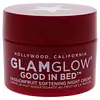What's inside
What's inside
 Key Ingredients
Key Ingredients

 Benefits
Benefits

 Concerns
Concerns

 Ingredients Side-by-side
Ingredients Side-by-side

Water
Skin ConditioningSimmondsia Chinensis Seed Oil
EmollientGlycolic Acid
BufferingButylene Glycol
HumectantPersea Gratissima Oil
Skin ConditioningGlycerin
HumectantCetearyl Alcohol
EmollientButyrospermum Parkii Oil
EmollientPEG-150 Distearate
EmulsifyingPolyquaternium-37
Sodium Hydroxide
BufferingPassiflora Edulis Seed Oil
EmollientCitric Acid
BufferingTartaric Acid
BufferingLactic Acid
BufferingSalicylic Acid
MaskingSodium Hyaluronate
HumectantSqualane
EmollientHordeum Vulgare Extract
EmollientTriticum Vulgare Germ Extract
Skin ConditioningAloe Barbadensis Leaf Juice
Skin ConditioningAlgae Extract
EmollientTocopheryl Acetate
AntioxidantCaffeine
Skin ConditioningSucrose
HumectantBiosaccharide Gum-1
HumectantPantethine
EmollientXanthan Gum
EmulsifyingParfum
MaskingLimonene
PerfumingLinalool
PerfumingPhenoxyethanol
PreservativeCI 19140
Cosmetic ColorantCI 15985
Cosmetic ColorantWater, Simmondsia Chinensis Seed Oil, Glycolic Acid, Butylene Glycol, Persea Gratissima Oil, Glycerin, Cetearyl Alcohol, Butyrospermum Parkii Oil, PEG-150 Distearate, Polyquaternium-37, Sodium Hydroxide, Passiflora Edulis Seed Oil, Citric Acid, Tartaric Acid, Lactic Acid, Salicylic Acid, Sodium Hyaluronate, Squalane, Hordeum Vulgare Extract, Triticum Vulgare Germ Extract, Aloe Barbadensis Leaf Juice, Algae Extract, Tocopheryl Acetate, Caffeine, Sucrose, Biosaccharide Gum-1, Pantethine, Xanthan Gum, Parfum, Limonene, Linalool, Phenoxyethanol, CI 19140, CI 15985
Water
Skin ConditioningGlycerin
HumectantNiacinamide
SmoothingIsohexadecane
EmollientSodium Starch Octenylsuccinate
AbsorbentIsopropyl Isostearate
EmollientStearyl Alcohol
EmollientPanthenol
Skin ConditioningTrehalose
HumectantSodium Hyaluronate
HumectantDimethicone
EmollientC13-14 Isoparaffin
EmollientCaprylyl Glycol
EmollientDimethiconol
EmollientLaureth-7
EmulsifyingCetearyl Glucoside
EmulsifyingCetearyl Alcohol
EmollientStearic Acid
CleansingPalmitic Acid
EmollientCetyl Alcohol
EmollientBehenyl Alcohol
EmollientDisodium EDTA
Polyacrylamide
PEG-100 Stearate
Ceramide AP
Skin Conditioning1,2-Hexanediol
Skin ConditioningPhenoxyethanol
PreservativeWater, Glycerin, Niacinamide, Isohexadecane, Sodium Starch Octenylsuccinate, Isopropyl Isostearate, Stearyl Alcohol, Panthenol, Trehalose, Sodium Hyaluronate, Dimethicone, C13-14 Isoparaffin, Caprylyl Glycol, Dimethiconol, Laureth-7, Cetearyl Glucoside, Cetearyl Alcohol, Stearic Acid, Palmitic Acid, Cetyl Alcohol, Behenyl Alcohol, Disodium EDTA, Polyacrylamide, PEG-100 Stearate, Ceramide AP, 1,2-Hexanediol, Phenoxyethanol
Ingredients Explained
These ingredients are found in both products.
Ingredients higher up in an ingredient list are typically present in a larger amount.
Cetearyl alcohol is a mixture of two fatty alcohols: cetyl alcohol and stearyl alcohol. It is mainly used as an emulsifier. Emulsifiers help prevent the separation of oils and products. Due to its composition, it can also be used to thicken a product or help create foam.
Cetearyl alcohol is an emollient. Emollients help soothe and hydrate the skin by trapping moisture.
Studies show Cetearyl alcohol is non-toxic and non-irritating. The FDA allows products labeled "alcohol-free" to have fatty alcohols.
This ingredient is usually derived from plant oils such as palm, vegetable, or coconut oils. There is debate on whether this ingredient will cause acne.
Due to the fatty acid base, this ingredient may not be Malassezia folliculitis safe.
Learn more about Cetearyl AlcoholGlycerin is already naturally found in your skin. It helps moisturize and protect your skin.
A study from 2016 found glycerin to be more effective as a humectant than AHAs and hyaluronic acid.
As a humectant, it helps the skin stay hydrated by pulling moisture to your skin. The low molecular weight of glycerin allows it to pull moisture into the deeper layers of your skin.
Hydrated skin improves your skin barrier; Your skin barrier helps protect against irritants and bacteria.
Glycerin has also been found to have antimicrobial and antiviral properties. Due to these properties, glycerin is often used in wound and burn treatments.
In cosmetics, glycerin is usually derived from plants such as soybean or palm. However, it can also be sourced from animals, such as tallow or animal fat.
This ingredient is organic, colorless, odorless, and non-toxic.
Glycerin is the name for this ingredient in American English. British English uses Glycerol/Glycerine.
Learn more about GlycerinPhenoxyethanol is a preservative that has germicide, antimicrobial, and aromatic properties. Studies show that phenoxyethanol can prevent microbial growth. By itself, it has a scent that is similar to that of a rose.
It's often used in formulations along with Caprylyl Glycol to preserve the shelf life of products.
Sodium Hyaluronate is hyaluronic acid's salt form. It is commonly derived from the sodium salt of hyaluronic acid.
Like hyaluronic acid, it is great at holding water and acts as a humectant. This makes it a great skin hydrating ingredient.
Sodium Hyaluronate is naturally occurring in our bodies and is mostly found in eye fluid and joints.
These are some other common types of Hyaluronic Acid:
Learn more about Sodium HyaluronateWater. It's the most common cosmetic ingredient of all. You'll usually see it at the top of ingredient lists, meaning that it makes up the largest part of the product.
So why is it so popular? Water most often acts as a solvent - this means that it helps dissolve other ingredients into the formulation.
You'll also recognize water as that liquid we all need to stay alive. If you see this, drink a glass of water. Stay hydrated!
Learn more about Water